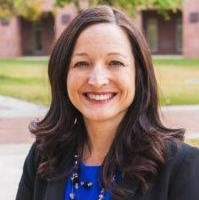
Dr. Justin Burris
Guest blog by Dr. Lynda Scott and Michael Harper
In this time of uncertainty, teacher educators are faced with many unknowns and have had to quickly shift their coursework to online and hybrid formats. This has been a particular challenge for teacher educators who are working with teacher candidates in courses that require experiences in the field. Dr. Justin Burris, a clinical assistant professor in the College of Education at the University of Houston, identified a need within his course to provide teacher candidates an opportunity to practice teaching in online formats. Dr. Burris shifted one of the final assignments in his course to allow teacher candidates to get support and experience teaching in online spaces. More importantly, he created a clear focus on using inquiry-based instruction within online formats, as well as providing high-quality academic feedback to K12 students throughout the experience. We recently sat down with Dr. Burris and asked him to share the assignment he created and how it impacted his students and his own instruction.
DR. SCOTT & MR. HARPER: None of us could have predicted COVID-19, and while many teacher educators and teachers struggled to adapt to the virtual environment, you quickly shifted one of your assignments to allow students to get support and experience teaching in an online space. Can you tell me about the assignment you created?
DR. BURRIS: I really wanted to provide my teacher candidates an opportunity to practice teaching online, so I developed an assignment that is an online mini-teach lesson that focused on high-leverage practices—such as those identified in the Teacher Educator Practice Framework—and high-leverage content. Essentially, teacher candidates had to design an online lesson and then include a video of them teaching that lesson. This provided them space to practice online teaching, which they had never done before. It also had the added benefit of creating an artifact the teacher candidates could show principals during interviews as an example of their online teaching.
I wanted the video they created through this assignment to include a short introduction to a standards-based activity using virtual manipulatives or common household tools. Then, I wanted candidates to provide an opportunity for students to post, write or talk with the teacher. Finally, candidates had to conduct a lesson closure.
An important aspect of the assignment is that the mini-lesson they designed should move students toward independence as learners, rather than dependence on the teacher or, during distance learning, their parents. Their lesson also needed to give feedback to students about their learning, as this is another crucial component of teaching, whether online or in-person. I noticed parents were frustrated with helping their children with schoolwork at home because teachers were struggling with providing academic feedback. This assignment provided a space for teacher candidates to provide that feedback either online or through phone conferences.
“The mini-lesson they designed should move students toward independence as learners, rather than dependence on the teacher or, during distance learning, their parents.”
DR. SCOTT & MR. HARPER: What inspired you to provide this opportunity to your teacher candidates and how did you develop it?
DR. BURRIS: We were moving happily along with the semester and then COVID happened. My teacher candidates who were finishing student teaching did not have any experiences teaching online and I knew that principals were going to need the new teaching workforce to be capable of teaching in a virtual environment. I therefore wanted this opportunity to:
1) make sure that my teacher candidates had a scaffold for teaching online;
2) provide a safe place to practice teaching online;
3) ensure teacher candidates had the experience of teaching online and providing academic feedback; and
4) provide an artifact that the teacher candidates can show to principals as examples of online teaching.
I developed the assignment using an inquiry model of instruction. This means that while the teacher sets students up for the learning, the cognitive load or thinking actually rests on the students. I then tailored the assignment and the assignment’s rubric to include both the confines of technology as well as the affordances of technology.
DR. SCOTT & MR. HARPER: In reflecting on the assignment, what excites you the most? What does it inspire you to do next?
DR. BURRIS: One of my teacher candidates, Jeffery, was in a third-grade classroom. He therefore chose a third grade state standard for his mini-lesson, which he selected in collaboration with his mentor teacher. It’s important to note that throughout the teacher candidate year-long residency, candidates co-teach with their mentor teacher. As a part of this co-teaching model, we encourage them to develop strong planning practices with their mentor teacher and employ a variety of co-teaching approaches. I’m excited that this assignment provided an additional opportunity for my teacher candidates to collaborate with their mentors and practice planning high-quality instruction.
“I’m excited that this assignment provided an additional opportunity for my teacher candidates to collaborate with their mentors and practice planning high-quality instruction.”
In terms of what I want to do next, well, I want to change my assignments all the time! In my math methods course, I plan to modify an assignment where teacher candidates use professional journals, specifically Teaching Children Mathematics and Mathematics Teacher: Learning & Teaching PK-12, to find a grade level specific activity or game that aligns to the state standard. In the current conception of this assignment, teacher candidates prepare the game or activity for an in-class rehearsal of their teaching to a small group of peers. I’m now thinking about combining the online teaching assignment and this “Learning from Professional Journals” assignment. This would give teacher candidates the opportunity to teach online, investigate a peer-reviewed journal, demonstrate their teaching and hopefully create a bank of activities/games that parents can play at home with their children. I would then definitely add these to our UH Math YouTube Channel.
DR. SCOTT & MR. HARPER: If I were to ask your teacher candidates about the experience, what do you think they would say were their biggest takeaways?
DR. BURRIS: I think teacher candidates would say that a) it takes more work to organize and deliver an online lesson, and b) it requires more effort to interact with students in a meaningful way online. It can also be challenging to provide academic feedback in online settings, which the teacher candidates had to grapple with in this assignment. For example, they had to identify ways to engage with students and have them explain their thinking.
“I will always have an assignment for online teaching and learning in all my courses. I think that we cannot escape this reality, so I want my teacher candidates to be prepared, whether they teach online or not.”
Teacher candidates also appreciated this assignment because they were able to contribute to their classroom and support their mentor teacher in much the same way as they had in their first semester of student teaching. For example, they were able to co-teach alongside their mentor and respond to students in different ways, despite the move to a virtual space.
DR. SCOTT & MR. HARPER: And for you? What impact has this assignment had on your practice as a teacher educator?
DR. BURRIS: Moving forward, I will always have an assignment for online teaching and learning in all my courses. I think that we cannot escape this reality, so I want my teacher candidates to be prepared, whether they teach online or not.
DR. SCOTT & MR. HARPER: I’m certain that other teacher educators will be excited to adapt this assignment in their own courses. What impact do you hope this resource has on them and their teacher candidates?
DR. BURRIS: I hope that teacher candidates understand that relationships, specifically interpersonal relationships, are so important to the academic, social and emotional growth of our students. We therefore have to find new ways to connect with students online and provide them opportunities to share their thinking with the teacher and with each other.
I also hope the resource will empower teacher candidates and maybe even their mentor teachers and future teacher colleagues to use more inquiry-based instruction in online settings, as well as to find ways to provide high-quality academic feedback during online instruction.
Finally, I want teacher candidates to acknowledge how poverty, racism, bias and social inequities deprive students, particularly students of color, of online learning opportunities. For example, only 30 percent of students in our partner district have access to the technology and internet required for participation in the online learning cycle.
“I want teacher candidates to acknowledge how poverty, racism, bias and social inequities deprive students, particularly students of color, of online learning opportunities.”
DR. SCOTT & MR. HARPER: Can you tell me a little bit more about how this assignment addresses educational inequities?
DR. BURRIS: This assignment calls attention to these inequities because not all students have the online tools necessary to participate in the lesson they designed. The district contacts students by phone and provides packets to students who are not connecting online. By recognizing that the lesson they designed is only accessible to some students, teacher candidates have to acknowledge the role that poverty, racism, bias and social inequities play in limiting student learning opportunities. Teacher candidates can adapt these online lessons for students without direct connections to their schools thereby providing access and opportunity to all students. This is a continued struggle. How do we engage students who are not in contact with the school or teacher? What might those lessons and activities look like at home? How can we provide feedback to students in a meaningful way?
DR. SCOTT & MR. HARPER: What kinds of racial or other identity awareness do teacher candidates need to bring to this assignment to get the most out of it?
DR. BURRIS: We need to know and understand our students, their families, their culture and their community. I realized that this assignment was not going to reach all the elementary students that our teacher candidates support, as the assignment focused on teaching in an online setting. However, I hope that the assignment underscores social inequities, including access to internet and technology, and pushes teacher candidates to consider the implications of online learning for all students. Again, I don’t have a solution for all of these challenges, but it’s absolutely something we should think about and be mindful of moving forward.
“We need to know and understand our students, their families, their culture and their community.”
DR. SCOTT & MR. HARPER: It’s certainly a challenging time for all of our candidates, teachers and students. What advice do you have for others who want to use this assignment with their own teacher candidates?
DR. BURRIS: I would connect your assignment to your university or state’s EPP or TPP standards. For example, in Texas we use T-TESS which is a rubric used to outline best practices for teachers. University of Houston uses the T-TESS throughout our teacher preparation program to support their development of the skills and knowledge they will need to be teachers in our partner schools. I want teacher candidates to know and understand that the evaluation can be connected to both face-to-face and online teaching.
Also, teacher educators need to know about the learning management system of the partnering school district and how the district uses and manages technology. They should find out what types of technology and tools are being used in the classrooms, so that they can incorporate them in their own coursework. Teacher candidates should have opportunities to explore the types of resources and tools that they will be using in their field experiences. Teacher educators and candidates should also be aware of the current issues within the district in regards to technology access and the learning opportunities for all students.
Dr. Burris modeled a valuable skill for his students by monitoring and adjusting his instruction to meet the needs of his students and partner school district. His push for high-quality online instruction created a space for his students to practice a needed skill and also opened the door for students to deliver inquiry-based instruction for the K12 students with whom they worked. He also ensured that his students considered the implications of online instruction on all populations of students. He gave them an opportunity to explore online instruction and the benefits and challenges that it poses for teachers and students. Although he doesn’t consider his assignment to be “ground-breaking,” it is a great example of how teacher educators can model flexibility and promote rigorous learning experiences in online spaces while calling out issues of equity.
| Resource Center
You can find Dr. Justin Burris’ online mini-teach lesson here. In this activity, teacher candidates design a lesson and record themselves giving the lesson. This is an opportunity for teacher candidates to practice online teaching and to develop an artifact they can share with principals in the future. Additional resources to support your teacher candidates in shifting to online teaching are listed below:
To learn more about critical teacher educator practices, read the Teacher Educator Practice Framework. The framework identifies “assessing what novices know and are able to do” as a critical teacher educator practice and encourages teacher educators to assess what novice teachers are able to do through their performance on tasks that mirror the actual work of teaching and the skills they have been taught. |
This post is part of a blog series authored by leaders from seven networks of teacher preparation programs—Branch Alliance for Educator Diversity, Center for Transforming Alternative Preparation Pathways (CTAPP), Innovation Center for Educator Preparation (IC4EP), National Center for Teacher Residencies (NCTR), New York City Department of Education, TeachingWorks, and University-School Partnerships for the Renewal of Educator Preparation (US PREP)—who are working together to transform the way teachers are prepared. In this series, these leaders talk about who they are and why they want to tell stories about teacher transformation. Read the previous blogs here, and don’t forget to share the series with your colleagues. Feel free to send comments to info@education-first.com and sign up for our email list. We’ll be using #teacherprepmatters to spread the word, and invite you to do the same!


